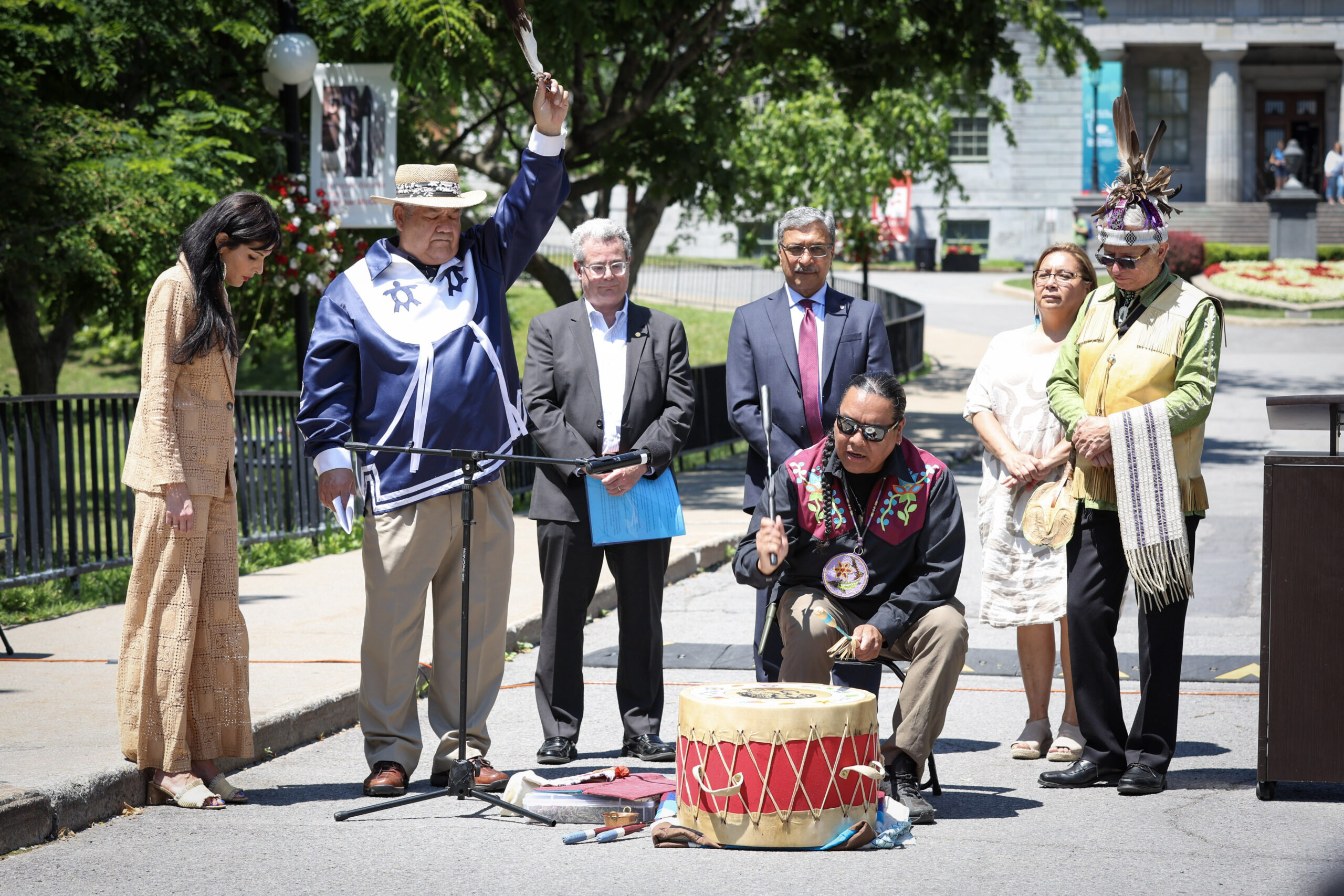
With a perfect north-easterly breeze behind it, the Hiawatha Wampum Belt Flag took pride of place atop the McCall MacBain Arts Building in honour of National Indigenous Peoples Day today.
As the flag rolled out across the warm blue sky, members of the McGill community gathered at the Y intersection to listen to speakers share their perspectives on the significance of the day, which has been celebrated at the University since 2018.
Mohawk Faithkeeper and Elder Ka’nahsóhon Kevin Deer opened the ceremony by welcoming the gathering with the Words before All Else.
Ongoing effort at McGill
Principal and Vice-Chancellor Deep Saini followed with an address that emphasized McGill’s commitment to ensuring Indigenous peoples and culture have a place on campus.
“Embedding Indigeneity into the life of our University requires an ongoing effort,” the Principal said.
“It’s not something that we do just today; we must do it every day. And, very importantly, it calls upon us to engage in learning, open dialogue and relationship building with our broader Indigenous communities.
“So, together, on this day, let us do one thing – let us reaffirm our commitment to this important work and further dedicate our efforts to enhancing the presence, visibility, and, most importantly, the success of Indigenous members across our diverse McGill community.”
Reflecting on the role universities play in responding to the calls to action of Canada’s Truth and Reconciliation Commission, Provost and Vice-Principal (Academic) Christopher Manfredi noted that, although much remained to be done at McGill, progress had been made thanks to the efforts of many committed members of the University community.
“I’m particularly encouraged by the growth in the number of Indigenous faculty, staff and students at McGill,” the Provost said. “We celebrate the addition of these new Indigenous voices and the fresh perspectives they bring to our university community, and we reaffirm our commitment to supporting and amplifying those voices.
“Furthermore, we reaffirm our commitment to building bridges and maintaining an open, constructive and respectful dialogue with all stakeholders from Indigenous communities, and we welcome and acknowledge everyone’s contribution as it enables us to move forward on the road to reconciliation.”
Continuing to learn
Next, Ojibwe artist and educator Robert Spade, recently appointed Indigenous Cultural Adviser in McGill’s Office of Indigenous Initiatives, spoke of life and learning, before captivating the audience with a moving honour song and drum performance.
“We learn from what people call mistakes, but we call those lessons,” Spade said. “We have to live. Anybody that’s older than me is my elder – no matter where you’re from on our earth – because you carry life. Nobody knows where life is from. No one understands that, not the most learned doctor, academic, or spiritual person. We have a word for that: manidoo. Manidoo does not mean God. It means something that we don’t know about. We always continue to learn.”
Advancing reconciliation and decolonization
Celeste Pedri-Spade, Associate Provost (Indigenous Initiatives), drew the audience’s attention to the flag and all that it symbolized, saying:
“Today, at the sixth annual raising of the Hiawatha Wampum Belt Flag, we’re not just celebrating the meeting of Indigenous peoples in Canada, we are also celebrating our continued brilliance, our resilience, our existence, all of our medicines, our knowledges and our ways of being.
“Our great leaders in the past have always turned to the teachings of the Wampum Belt, which reminds us that we at McGill are here walking side by side with Onkwehon:we, and that this relationship begets specific responsibilities to Onkwehon:we. It is this relationship that in part culminated into our 52 Calls to Action, which details specific actions towards advancing reconciliation and decolonization here.
“And, for me, it is a privilege to work with a diverse team of First Nations, Inuit and Métis people towards actualizing many of these goals. As a team, it is an honour to be guided by many respected and knowledgeable Indigenous community advisers whose expertise is integral to our work – and many of them are standing here with us today.”
Meaningful relationships at the core of reconciliation
Reminding the gathering of another important June 21 event, the summer solstice, Pedri-Spade shared insights into the special meaning of this time of year.
“For Anishinaabeg, this month is Ode’imini-giizis, or Strawberry Moon – ‘ode’i’ is ‘heart’ and ‘min’ is our word for ‘berry’. In our ways of life, ode’imin, or heart-berry, or strawberry, is considered a woman’s medicine, and it is used to teach about things like creation, community, acceptance, love.
“To quote Elder Lillian Pitawanakwat from back west, she would say, ‘in a way, ode’imin teaches us about how meaningful relationships are at the core of healthy communities and are at the core of the work of reconciliation.’”
Every day a day to remember
To close the event, Elder Mike Loft, cultural adviser from Kahnawake, shared his knowledge about the Hiawatha Wampum Belt Flag and its symbolic significance for the five Haudenosaunee nations.
“The Hiawatha Belt Flag is the national belt of the Haudenosaunee,” he said. “It is pre-Columbian, and it’s a symbol of unity and peace after the Peacemaker convinced our people – the Mohawk, Oneida, Onondaga, Cayuga and Seneca – to put down the weapons of war.”
Loft concluded his remarks by saying, “National Indigenous Peoples Day gives all Canadians a chance to discover the rich history and gifts Indigenous peoples have made to shape this land since the dawn of time.
“Remember that every day – not just this day, but every day – is sacred in this world. Every day allows us a chance to honour and respect the Indigenous people of Canada, who have given so much to our collective identity and wellbeing.”
Watch the video of the ceremony below
